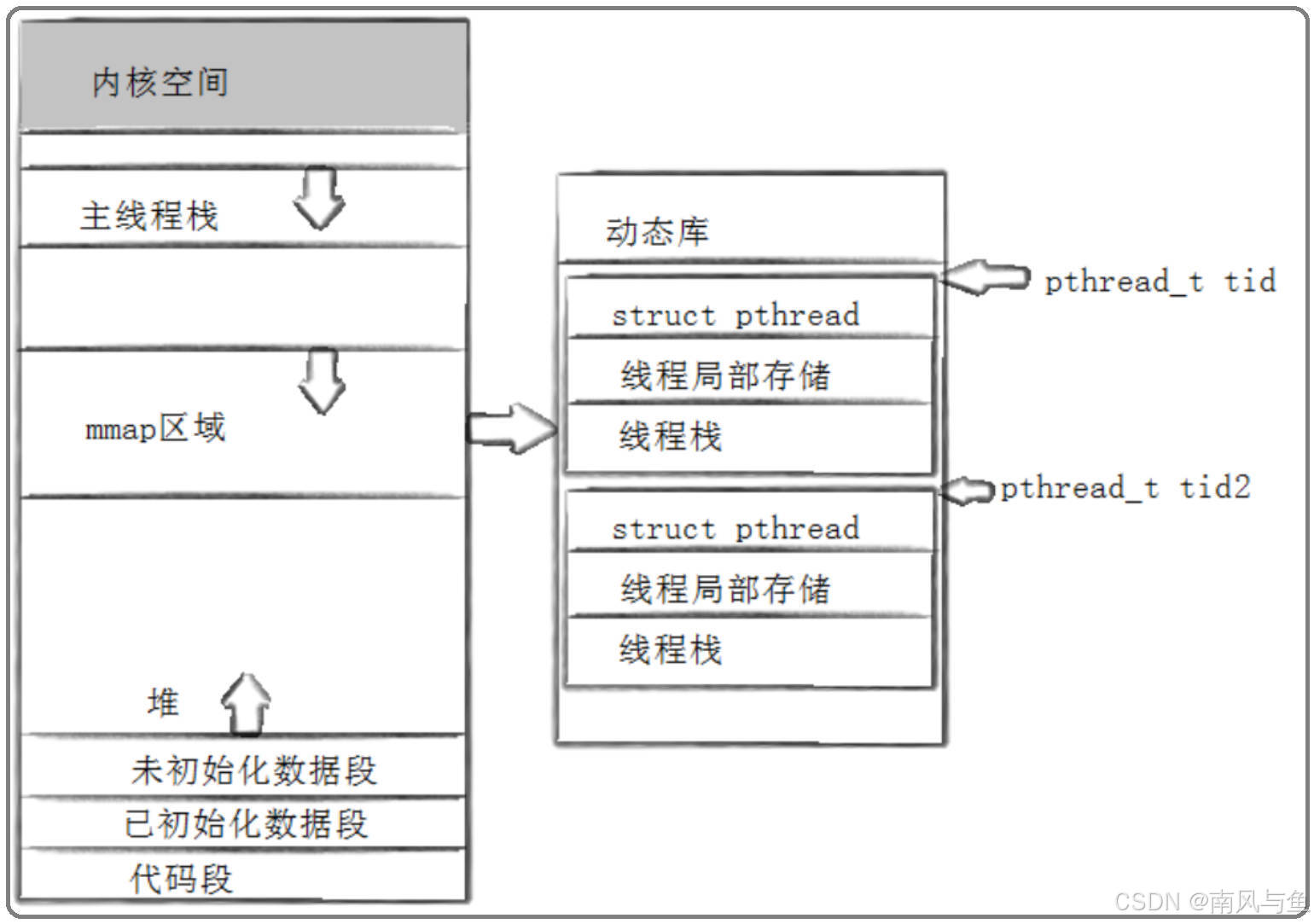好的品牌设计网站有哪些百度手机浏览器
目录
一、POSIX线程库简介
二、线程创建
2.1 单线程创建示例
2.2 多线程创建示例
2.3 线程ID的获取与使用
2.4 线程与进程的关系
2.5 线程的调度与LWP
三、线程等待
1. 为什么需要线程等待?
2. 线程等待实例
2.1 基本线程等待
2.2 获取线程退出码
3. 线程异常终止的影响
四、线程终止
1. 线程终止的三种方式
2. return:线程的自然结束
3. pthread_exit:线程的主动谢幕
4. pthread_cancel:线程的强制终止
五、分离线程
1. 什么是分离线程?
2. 自动分离线程
3. 分离线程的优势
4. 注意事项
六、线程ID与进程地址空间布局
1. 线程ID的双重身份
1.1 操作系统调度器的线程ID
1.2 NPTL线程库的线程ID
2. 线程ID的存储与管理
2.1 线程控制块(struct pthread)
2.2 线程栈与资源
3. 进程地址空间布局
一、POSIX线程库简介
POSIX线程库是一组标准化的线程接口,几乎所有支持POSIX标准的系统(比如Linux、macOS)都内置了对它的支持。它的核心函数都以 pthread_ 开头,使用时需要包含头文件<pthread.h>,并在编译时加上 -lpthread 选项。
线程是进程中的一个执行单元,多个线程共享同一进程的资源(比如内存、文件描述符等),但它们可以独立运行。线程的轻量化特性使得它在处理并发任务时比进程更加高效。
二、线程创建
创建线程的核心函数是 pthread_create,它的原型如下:
int pthread_create(pthread_t *thread, const pthread_attr_t *attr, void *(*start_routine)(void*), void *arg);
thread:用于存储新创建线程的ID。
attr:线程属性(比如栈大小、优先级等),通常传NULL表示使用默认属性。
start_routine:线程启动后执行的函数地址。
arg:传递给启动函数的参数。- 线程创建成功返回0,失败返回错误码。
2.1 单线程创建示例
我们先从最简单的例子开始:主线程创建一个新线程。
#include <stdio.h>
#include <pthread.h>
#include <unistd.h>// 线程执行的函数
void* thread_function(void* arg)
{char* msg = (char*)arg;while (1) {printf("I am %s\n", msg); // 打印线程信息sleep(1); // 模拟任务执行}return NULL; // 线程结束
}int main()
{pthread_t tid; // 存储线程IDpthread_create(&tid, NULL, thread_function, (void*)"thread 1"); // 创建线程while (1) {printf("I am main thread!\n"); // 主线程任务sleep(2);}return 0;
}运行后,你会看到主线程和新线程交替打印信息。新线程每秒打印一次,而主线程每两秒打印一次。

当我们用 ps axj 命令查看当前进程的信息时,虽然此时该进程中有两个线程,但是我们看到的进程只有一个,因为这两个线程都是属于同一个进程的。

2.2 多线程创建示例
如果我们想创建多个线程,可以稍微修改代码:
#include <stdio.h>
#include <stdlib.h>
#include <pthread.h>
#include <unistd.h>void* thread_function(void* arg)
{char* msg = (char*)arg;while (1) {printf("I am %s...tid: %lu\n", msg, getpid()); // 打印线程IDsleep(1);}return NULL;
}int main()
{pthread_t threads[5]; // 存储5个线程IDfor (int i = 0; i < 5; i++) {char* msg = (char*)malloc(64);sprintf(msg, "thread %d", i); // 动态生成线程名称pthread_create(&threads[i], NULL, thread_function, msg);}while (1) {printf("I am main thread...tid: %lu\n", getpid()); // 主线程IDsleep(2);}return 0;
}运行后,你会看到5个新线程和主线程同时运行,主线程和新线程的PID是一样的,也就是说主线程和新线程虽然是两个执行流,但它们仍然属于同一个进程。

2.3 线程ID的获取与使用
线程ID是区分线程的重要标识,获取方式有两种:
-
创建线程时通过输出型参数获取:这是
pthread_create的默认行为。 -
调用
pthread_self函数:返回当前线程的ID。
pthread_t pthread_self(void);代码示例:
#include <stdio.h>
#include <pthread.h>
#include <unistd.h> // 用于 sleep 函数// 线程函数
void* thread_function(void* arg)
{// 获取当前线程的 IDpthread_t tid = pthread_self();// 将 pthread_t 转换为 unsigned long 以便打印printf("子线程 ID: %lu\n", (unsigned long)tid);sleep(1);return NULL;
}int main()
{pthread_t thread_id;// 创建一个新线程if (pthread_create(&thread_id, NULL, thread_function, NULL) != 0) {perror("线程创建失败");return 1;}// 主线程中打印自己的线程 IDprintf("主线程 ID: %lu\n", (unsigned long)pthread_self());return 0;
}
2.4 线程与进程的关系
线程是进程中的一个执行单元,多个线程共享同一进程的资源。我们可以通过getpid和getppid函数验证这一点:
#include <stdio.h>
#include <pthread.h>
#include <unistd.h>void* thread_function(void* arg)
{char* msg = (char*)arg;while (1) {printf("I am %s...pid: %d, ppid: %d\n", msg, getpid(), getppid());sleep(1);}return NULL;
}int main()
{pthread_t tid;pthread_create(&tid, NULL, thread_function, (void*)"thread 1");while (1) {printf("I am main thread...pid: %d, ppid: %d\n", getpid(), getppid());sleep(2);}return 0;
}
运行后,你会发现主线程和新线程的pid和ppid完全相同,这说明它们属于同一个进程。
2.5 线程的调度与LWP
在Linux中,线程实际上是通过内核的轻量级进程(LWP)实现的。每个线程都有一个对应的LWP,而LWP才是操作系统调度的最小单位。
#include <stdio.h>
#include <pthread.h>
#include <stdlib.h>
#include <unistd.h>#define NUM_THREADS 3// 线程函数:打印线程 ID
void *thread_task(void *arg)
{int thread_id = *(int *)arg;for (int i = 0; i < 3; i++){printf("线程 %d (pthread_t: %lu) - 执行次数: %d\n",thread_id, (unsigned long)pthread_self(), i);sleep(1);}return NULL;
}int main()
{pthread_t threads[NUM_THREADS];int thread_args[NUM_THREADS];// 创建多个线程for (int i = 0; i < NUM_THREADS; i++){thread_args[i] = i;pthread_create(&threads[i], NULL, thread_task, &thread_args[i]);}// 主线程也打印自己的线程 IDprintf("主线程 ID: %lu\n", (unsigned long)pthread_self());// 等待所有子线程结束for (int i = 0; i < NUM_THREADS; i++){pthread_join(threads[i], NULL);}return 0;
}我们可以通过ps -aL命令查看线程的LWP信息:

运行上面的命令,你会看到每个线程的LWP ID,以及它们所属的进程ID(PID)。
三、线程等待
1. 为什么需要线程等待?
线程被创建后,就像进程一样,它的资源需要被回收。如果不等待线程结束,这些资源就会变成“僵尸”,导致内存泄漏。就像餐厅的服务员完成任务后,经理需要确认他们已经下班,否则餐厅的运营效率会受到影响。
线程等待的核心函数是 thread_join,它的原型如下:
int pthread_join(pthread_t thread, void **retval);
thread:需要等待的线程ID。
retval:存储线程退出时的返回值。返回值:成功返回0,失败返回错误码。
调用pthread_join的线程会挂起,直到目标线程结束。
2. 线程等待实例
2.1 基本线程等待
我们先来看一个简单的例子,主线程创建5个新线程,并等待它们完成。
#include <stdio.h>
#include <stdlib.h>
#include <pthread.h>
#include <unistd.h>// 线程执行函数
void *thread_function(void *arg)
{char *msg = (char *)arg;int count = 0;while (count < 5){printf("I am %s...tid: %lu\n", msg, pthread_self());sleep(1);count++;}return NULL; // 正常退出
}int main()
{pthread_t threads[5]; // 存储5个线程IDfor (int i = 0; i < 5; i++){char *msg = (char *)malloc(64);sprintf(msg, "thread %d", i);pthread_create(&threads[i], NULL, thread_function, msg);}// 等待所有线程完成for (int i = 0; i < 5; i++){pthread_join(threads[i], NULL);printf("Thread %d[%lu]...done\n", i, threads[i]);}return 0;
}运行后,你会看到每个线程打印5次信息,然后主线程依次等待它们完成。

2.2 获取线程退出码
线程退出时可以返回一个值,就像函数返回值一样。我们可以通过pthread_join获取这个值。
#include <stdio.h>
#include <stdlib.h>
#include <pthread.h>
#include <unistd.h>// 线程执行函数
void *thread_function(void *arg)
{char *msg = (char *)arg;int count = 0;while (count < 5){printf("I am %s...tid: %lu\n", msg, pthread_self());sleep(1);count++;}return (void *)2023; // 返回退出码
}int main()
{pthread_t threads[5];for (int i = 0; i < 5; i++){char *msg = (char *)malloc(64);sprintf(msg, "thread %d", i);pthread_create(&threads[i], NULL, thread_function, msg);}// 等待并获取退出码for (int i = 0; i < 5; i++){void *exit_code;pthread_join(threads[i], &exit_code);printf("Thread %d[%lu]...done, exit code: %d\n", i, threads[i], (int)exit_code);}return 0;
}运行后,你会看到每个线程的退出码被成功捕获。

3. 线程异常终止的影响
线程异常终止(比如崩溃)会导致整个进程崩溃。这是因为线程共享进程的资源,一个线程的崩溃会影响整个进程。
#include <stdio.h>
#include <stdlib.h>
#include <pthread.h>
#include <unistd.h>// 线程执行函数
void *thread_function(void *arg)
{char *msg = (char *)arg;int count = 0;while (count < 5){printf("I am %s...tid: %lu\n", msg, pthread_self());sleep(1);count++;int a = 1 / 0; // 故意制造错误}return NULL;
}int main()
{pthread_t threads[5];for (int i = 0; i < 5; i++){char *msg = (char *)malloc(64);sprintf(msg, "thread %d", i);pthread_create(&threads[i], NULL, thread_function, msg);}// 等待线程(可能永远不会到达这里)for (int i = 0; i < 5; i++){pthread_join(threads[i], NULL);}return 0;
}
运行这段代码,你会发现一旦某个线程崩溃,整个程序都会退出。这说明多线程程序的健壮性需要特别注意。

四、线程终止
1. 线程终止的三种方式
在POSIX线程库中,有三种方式可以终止线程:
-
从线程函数返回:就像函数执行完毕一样,线程自然结束。
-
调用
pthread_exit:线程主动请求结束自己。 -
调用
pthread_cancel:由其他线程强制终止某个线程。
2. return:线程的自然结束
核心原理:通过函数返回来结束线程执行流
特点:
-
主线程return会导致进程终止
-
子线程return仅终止当前线程
void* worker(void* arg) {int count = 0;while(count++ < 3) {printf("子线程工作中...\n");sleep(1);}return NULL; // 正常退出
}int main() {pthread_t tid;pthread_create(&tid, NULL, worker, NULL);// 主线程立即返回导致进程终止return 0; // 错误示例!子线程来不及执行
}
执行现象:看不到任何输出,因为主线程退出导致进程终止
3. pthread_exit:线程的主动谢幕
API:pthread_exit(void *retval)
特性:
-
可携带退出状态码
-
退出码内存必须全局或堆分配
#include <stdio.h>
#include <stdlib.h>
#include <pthread.h>
#include <unistd.h>void* task(void* arg)
{int* exit_code = malloc(sizeof(int)); // 必须堆分配*exit_code = 2023;for(int i=0; i<3; i++){printf("处理任务阶段%d\n", i+1);sleep(1);}pthread_exit(exit_code); // 携带状态码退出
}int main()
{pthread_t tid;void* ret_val;pthread_create(&tid, NULL, task, NULL);pthread_join(tid, &ret_val);printf("线程退出码:%d\n", *(int*)ret_val);free(ret_val); // 记得释放堆内存return 0;
}
4. pthread_cancel:线程的强制终止
API:pthread_cancel(pthread_t thread)
重要特性:
-
异步终止可能引发资源泄漏
-
被取消线程退出码为-1(PTHREAD_CANCELED)
#include <stdio.h>
#include <stdlib.h>
#include <pthread.h>
#include <unistd.h>// 线程执行函数
void *thread_function(void *arg)
{char *msg = (char *)arg;int count = 0;while (count < 5){printf("I am %s...tid: %lu\n", msg, pthread_self());sleep(1);count++;}pthread_exit((void *)2025);
}int main()
{pthread_t threads[5];for (int i = 0; i < 5; i++){char *msg = (char *)malloc(64);sprintf(msg, "thread %d", i);pthread_create(&threads[i], NULL, thread_function, msg);}// 取消前4个线程for (int i = 0; i < 4; i++){pthread_cancel(threads[i]);printf("Canceled thread %d[%lu]\n", i, threads[i]);}// 等待所有线程for (int i = 0; i < 5; i++){void *ret;pthread_join(threads[i], &ret);printf("Thread %d[%lu]...done, exit code: %d\n", i, threads[i], (int)ret);}return 0;
}
运行后,你会发现前4个线程被强制终止,退出码为-1,而第5个线程正常结束。
五、分离线程
1. 什么是分离线程?
分离线程是一种特殊的线程状态,它告诉系统:当线程退出时,自动释放所有资源,无需手动调用pthread_join。就像快递员完成任务后直接离开,不需要快递公司再确认他是否完成任务。
分离线程的核心函数是pthread_detach,它的原型如下:
int pthread_detach(pthread_t thread);-
thread:需要分离的线程ID。 -
返回值:成功返回0,失败返回错误码。
分离线程后,线程的资源会在它退出时自动释放。一个线程不能同时是joinable和分离的。
2. 自动分离线程
我们可以通过pthread_detach将线程设置为分离状态。例如:
#include <stdio.h>
#include <stdlib.h>
#include <pthread.h>
#include <unistd.h>// 线程执行函数
void *thread_function(void *arg)
{printf("%s\n", (char *)arg); // 打印传入的消息pthread_detach(pthread_self()); // 将自己设置为分离线程return NULL;
}int main()
{pthread_t tid;if (pthread_create(&tid, NULL, thread_function, "Hello from detached thread!") != 0){printf("Failed to create thread\n");return 1;}// 等待一段时间,确保线程完成sleep(1);// 尝试等待线程(会失败,因为线程已经分离)if (pthread_join(tid, NULL) == 0){printf("Thread joined successfully\n");}else{printf("Failed to join thread (expected behavior for detached thread)\n");}return 0;
}运行后,你会看到线程打印了消息,但pthread_join会失败,因为线程已经分离。

3. 分离线程的优势
分离线程非常适合以下场景:
-
不关心线程返回值:比如后台日志记录线程,我们只需要它运行,不需要关心它的结果。
-
简化代码:避免手动等待线程,减少代码复杂度。
4. 注意事项
-
分离线程无法被等待:一旦线程被分离,
pthread_join将始终失败。 -
分离时机很重要:最好在主线程中等待一段时间,确保子线程完成分离操作。
-
资源自动释放:分离线程的资源会在它退出时自动释放,无需手动干预。
六、线程ID与进程地址空间布局
1. 线程ID的双重身份
1.1 操作系统调度器的线程ID
线程是操作系统调度器的最小单位,每个线程都有一个由内核分配的唯一标识符,称为轻量级进程ID(LWP ID)。这个ID用于操作系统调度线程。
1.2 NPTL线程库的线程ID
在Linux的NPTL(Native POSIX Thread Library)实现中,
pthread_create函数生成的线程ID是线程库内部使用的标识符。它本质上是一个指向线程控制块(struct pthread)的地址。pthread_t pthread_self(void);
pthread_t类型的线程ID是进程地址空间中的一个地址,指向线程的控制块。线程库通过这个地址来管理线程的生命周期。
2. 线程ID的存储与管理
2.1 线程控制块(struct pthread)
每个线程都有一个对应的控制块(
struct pthread),它存储了线程的栈、局部存储等信息。pthread_t类型的线程ID实际上是指向这个控制块的地址。
2.2 线程栈与资源
线程的栈和局部存储是线程运行时的核心资源。这些资源在进程的地址空间中分配,由线程库管理。
3. 进程地址空间布局
进程的地址空间由多个区域组成,包括内核空间、主线程栈、动态库、线程栈等。以下是具体布局:
内核空间:操作系统内核代码和数据。
主线程栈:主线程的栈空间。
动态库:加载的动态链接库。
线程控制块:每个线程的控制块。
线程栈:每个线程的栈空间。
堆:动态分配的内存区域。
未初始化数据段:未初始化的全局变量。
已初始化数据段:已初始化的全局变量。
代码段:程序的可执行代码。
